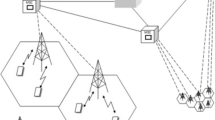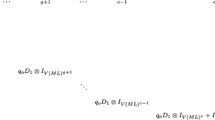Abstract
In this paper, we analyze the impact of delaying delay-tolerant calls under certain conditions in cellular networks. We propose to queue the call if the user agrees when the terminal has bad radio conditions and the system is loaded. The call is served as soon as radio conditions become good or the current load goes below a given threshold. We model the system as a continuous-time Markov chain, which allows us to compute the blocking probability, the mean waiting time and the mean service time. Numerical results show that when the proportion of users with delay tolerance is 20%, the system can bear 16% more calls with the same blocking probability, and 113% more calls if 80% of users are delay tolerant.









Similar content being viewed by others
Notes
The blocking probability of handover is not taken into account since it is negligible.
References
Jonsson, P., & Carson, S. (2018). Ericsson mobility report.
Yeh, S. P., Talwar, S., Wu, G., Himayat, N., & Johnsson, K. (2011). Capacity and coverage enhancement in heterogeneous networks. IEEE Wireless Communications, 18(3), 32–38.
Falowo, O. E., & Chan, H. A. (2011). Effect of mobile terminal heterogeneity on call blocking/dropping probability in cooperative heterogeneous cellular networks. Telecommunication Systems, 47(3–4), 337–349.
Ghosh, A., Mangalvedhe, N., Ratasuk, R., Mondal, B., Cudak, M., Visotsky, E., et al. (2012). Heterogeneous cellular networks: From theory to practice. IEEE Communications Magazine, 50(6), 54–64.
Li, P., Gong, S., Gao, S., Hu, Y., Pan, Z., & You, X. (2019). Delay-constrained sleeping mechanism for energy saving in cache-aided ultra-dense network. Science China Information Sciences, 62(8), 82301.
Pramanik, P. K. D., & Choudhury, P. (2020). Mobility-aware service provisioning for delay tolerant applications in a mobile crowd computing environment. SN Applied Sciences, 2(3), 1–17.
Balasubramanian, A., Mahajan, R., & Venkataramani, A. (2010). Augmenting mobile 3G using WiFi. In Proceedings of the ACM MobiSys (pp. 209–222), San Francisco, California, USA, June 15–18.
Dimatteo, S., Hui, P., Han, B., & Li, V.O.K. (2011) Cellular traffic offloading through WiFi networks. In Proceedings of the IEEE MASS (pp. 192–201).
Trestian, I., Ranjan, S., Kuzmanovic, A., & Nucci, A. (2012). Taming the mobile data deluge with drop zones. IEEE/ACM Transactions on Networking, 20(4), 1010–1023.
Hagos, D. H. (2016). The performance of network-controlled mobile data offloading from LTE to WiFi networks. Telecommunication Systems, 61(4), 675–694.
Bonald, T., & Proutière, A. (2003). Wireless downlink data channels: User performance and cell dimensioning. In Proceedings of the ACM MobiCom (pp. 339–352).
Munoz, E. A. C., Le Denmat, F., Morin, A., & Lagrange, X. (2015). Multimedia content delivery trigger in a mobile network to reduce the peak load. Annals of telecommunications-annales des télécommunications, 70(7–8), 321–330.
Gamboa, S., Pelov, A., Maillé, P., Lagrange, X., & Montavont, N. (2017). Reducing the energy footprint of cellular networks with delay-tolerant users. IEEE Systems Journal, 11(2), 729–739.
Baloch, R. A., Awan, I., & Min, G. (2010). A mathematical model for wireless channel allocation and handoff schemes. Telecommunication Systems, 45(4), 275–287.
Fazio, P., Tropea, M., Sottile, C., Marano, S., Voznak, M., & Strangis, F. (2014). Mobility prediction in wireless cellular networks for the optimization of call admission control schemes. In Proceedings of 27th IEEE Canadian conference on electrical and computer engineering (CCECE) (pp. 1–5). IEEE.
Rappaport, T. S. (2014). Wireless communications principles and practice (2nd ed.). Upper Saddle River: Prentice Hall.
Guérin, R. A. (1987). Channel occupancy time distribution in a cellular radio system. IEEE Transactions on Vehicular Technology, 36(3), 89–99.
Kelif, J.-M., Coupechoux, M., & Godlewski, P. (2007). Spatial outage probability for cellular networks. In Proceedings of IEEE GLOBECOM vol. 522 (pp. 4445–4450).
Thomas, R., Gilbert, H., & Mazziotto, G. (1988). Influence of the moving of the mobile stations on the performance of a radio mobile cellular network. In Proceedings of the Nordic seminar on digital land mobile radio communications.
Munir, K., Lagrange, X., Bertin, P., Guillouard, K., & Ouzzif, M. (2015). Performance analysis of mobility management architectures in cellular networks. Telecommunication Systems, 59(2), 211–227.
Mahmoud, H. K., Coupechoux, M., & Godlewski, P. (June 2009). Traffic studies for DSA policies in a simple cellular context with packet services. In Proceedings of CROWNCOM.
Berggren, F., & Jäntti, R. (2004). Asymptotically fair transmission scheduling over fading channels. IEEE Transactions on Wireless Communications, 3(1), 326–336.
Author information
Authors and Affiliations
Corresponding author
Ethics declarations
Conflict of interest
On behalf of all authors, the corresponding author states that there is no conflict of interest.
Additional information
Publisher's Note
Springer Nature remains neutral with regard to jurisdictional claims in published maps and institutional affiliations.
Rights and permissions
About this article
Cite this article
Yan, F., Maillé, P. & Lagrange, X. Performance analysis of cellular networks with delay tolerant users. Telecommun Syst 77, 241–253 (2021). https://doi.org/10.1007/s11235-021-00752-7
Accepted:
Published:
Issue Date:
DOI: https://doi.org/10.1007/s11235-021-00752-7




